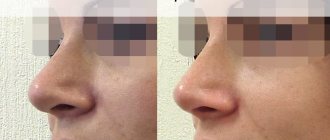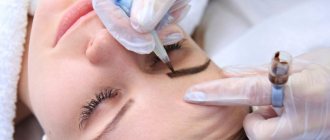The article was checked by a cardiologist, member of the European Society of Cardiology, the Eurasian Association of Cardiologists, the Russian Society of Holter Monitoring O.A. Lozbineva. , is for general informational purposes only and does not replace specialist advice. For recommendations on diagnosis and treatment, consultation with a doctor is necessary.
Edema is the medical term for the abnormal accumulation of fluid in certain tissues of the body. Parts of the body swell from injury or inflammation. Medicines, pregnancy and infections can also cause swelling. Fluid accumulation occurs when it is released from small blood vessels into nearby tissues.
Fluid accumulation may occur under the skin, usually in the lower extremities or lungs. The localization area can give the practitioner the first clues as to the main cause of the development of the pathological process in the body.
sign up for a consultation
Types of edema
Depends on origin:
- Lymphatic - those types of edema that are caused by causes and changes associated with the lymphatic system are considered as such. Among them are primary (there are congenital malformations of the lymphatic system, usually affecting the limbs), or secondary (there are acquired damage). The latter may be the result of operations to remove tumors in the lymphatic system, or in cases of burns, strokes or infections that cause vessel destruction.
- Dynamic - the lymphatic system does not show any changes, but excess fluid is felt. These include swelling of the veins caused by blood clots or problems with the blood vessels caused by strokes, inflammation, and medications. In women, the cause is varicose veins and exposure to hormones during pregnancy and the postpartum period.
The main factors are changes in the biochemical composition of tissue fluid and blood plasma. Disturbances also occur against the background of hormonal changes and increased capillary permeability.
Is it normal for swelling to appear after lip augmentation with hyaluronic acid?
According to statistics, more and more modern women are turning to a cosmetologist to correct the shape and increase the size of their lips using hyaluronic acid injections. It becomes not enough for them to have healthy, beautiful, well-groomed skin. This procedure is quite quick and does not pose any danger, is easily tolerated and has a short recovery period.
It is carried out as follows: the nasolabial area is anesthetized, treated with an antiseptic, then hyaluronic acid filler is injected directly into the lips to a depth of one or two millimeters with a syringe with a very thin needle. The whole process takes 15–20 minutes. During this time, no more than 20 injections are given.
Slight swelling after lip augmentation with hyaluronic acid is a normal reaction of the body to local microdamage to tissue.
Hyaluronate is a hydrophilic substance; it absorbs and retains water well. This is why swelling appears when the drug is artificially administered during the procedure. Under natural conditions, this acid is produced in the body and maintains youthful and elastic skin. For many women who are faced with the problem of severe swelling after lip augmentation with hyaluronic acid (see photo above), the urgent question is how to remove it and what to do if the swelling does not go away for a long time.
Read the material on the topic: Chemical peeling of the face: your skin will breathe a new breath!
Reasons for development
The veins in the legs have valves that act as "check valves" to prevent blood from flowing into the legs due to gravity. The heartbeat pushes blood through the arteries down to the legs. The blood must return to the heart to be recirculated through the veins. Blood pressure through the system and contracting leg muscles push blood up the veins, while valves prevent backflow down against gravity.
Valve insufficiency allows blood to pool in the legs and feet, eventually leading to swelling. When blood stagnates or pools in an area, fluid leaks into the surrounding tissue.
Valve insufficiency can occur for the following reasons:
- with age;
- from standing for long periods of time;
- from sitting for many hours;
- from varicose veins.
Regardless of the cause, as the valves in the legs become dysfunctional, blood pools and causes swelling, which puts pressure on the veins, causing them to widen and widen. This prevents the valves from working effectively, leading to even more swelling.
Main reasons for development:
- kidney diseases: glomerulonephritis, nephrotic syndrome, renal failure;
- heart diseases: heart failure;
- vein lesions (varicose veins, inflammation, thrombosis);
- liver diseases: cirrhosis of the liver, blockage of the hepatic veins;
- diseases of the endocrine system: hypothyroidism, diabetes;
- severe cancer;
- nutritional dystrophy;
- pregnancy;
- allergic reactions: insect bites, contact with an allergen.
Depending on the type, swelling can lead to retinal detachment, stroke, seizures, and even death. It is unacceptable to ignore the problem. To determine the cause, sign up for a consultation with specialists at the Yauza Hospital.
When swelling after tooth extraction is a cause for concern
If you are concerned that swelling is not going down, also pay attention to the following symptoms:
- the tumor has spread to a significant part of the face;
- swelling persists for more than five days;
- you continue to experience severe pain;
- your temperature is above 37.5;
- there was an unpleasant odor in the mouth;
- it hurts you to chew and swallow;
- the mucous membrane and skin turned red (an allergic reaction occurred).
The presence of one or more accompanying symptoms indicates that you are experiencing complications and should immediately consult a doctor to take the necessary measures to avoid serious consequences.
Edema as symptoms of diseases
In addition to vein problems, swelling can be caused by many other problems. In this case, clinical manifestations are usually observed on both legs.
Heart pathologies
When the heart begins to fail as a pump, fluid pools in areas such as the legs and lungs and causes swelling. In addition, less blood flows to the kidneys, causing fluid retention.
Lung diseases
The cause is acute pulmonary failure, which is associated with the release of transudate from the capillaries. This is fraught with infiltration of the alveoli and a sharp disruption of gas exchange in the lungs.
It manifests itself as shortness of breath at rest, suffocation, a feeling of tightness in the chest, cough with the release of foamy bloody sputum. Accompanied by the development of acidosis and hypoxia.
Kidney diseases
Excess fluid and sodium in the circulation can cause fluid to accumulate. Swelling associated with kidney disease usually occurs in the legs and around the eyes.
Damage to the tiny filtering blood vessels in the kidneys can lead to nephrotic syndrome. In nephrotic syndrome, decreased levels of protein (albumin) in the blood can lead to fluid accumulation.
Severe liver pathologies
With cirrhosis, as a rule, fluid accumulates in the abdominal cavity. Accompanied by liver failure, dilation of hemorrhoidal veins and bleeding from the esophagus.
Quincke's edema
An acute disease that is characterized by the appearance of limited angioedema of the skin and subcutaneous tissue, body systems and various organs. The reasons are autoimmune and infectious diseases, false and true allergies. It occurs acutely and goes away within 2-3 days.
Arthritis
During the inflammatory process in the joint area, a large amount of synovial fluid is released. It accumulates in the cavity of the articular structure. When inflammation spreads to adjacent soft tissues, extensive (spread) edema develops.
What other consequences might occur?
Some patients are interested in whether facial plastic surgery leaves swelling in combination with other consequences of the operation, or whether it is possible to do without consequences. The appearance of swelling and bruising is a common occurrence after almost any plastic surgery. This is completely normal and is not a cause for concern.
Also, common consequences of plastic surgery include a slight increase in temperature, pain in the intervention area, and slight discharge of blood and lymph from the incision sites in the first days. Small lumps may appear. In some cases, a decrease in sensitivity is observed in the correction area. If you notice one or more of the symptoms listed above, do not panic. If you are concerned, you can visit your surgeon.
We treat all types of edema
Specialists at the Yauza Clinical Hospital diagnose and treat edema of various origins. We follow international protocols and use modern equipment.
For cardiovascular diseases
“Cardiac” edema develops slowly – over several weeks or months. They are characterized by symmetry and increase in size in the evening. They first appear on the lower extremities or lower abdomen, in severe cases they spread throughout the body and are accompanied by the accumulation of fluid in the abdominal cavity (ascites) and enlarged liver. In this case, the skin most often feels cold to the touch and the swelling is dense. When pressed, a hole remains.
Patients complain of shortness of breath, which worsens when lying down, and low exercise tolerance. They have wheezing in the lungs, tachycardia, pallor of the lips, and cyanosis of the nasolabial triangle. As circulatory failure is compensated, swelling decreases or disappears.
Swelling due to venous insufficiency also becomes more pronounced in the evening, causing the sensation of shoes suddenly becoming tight (due to swelling of the feet), and the legs become visually thicker, often not symmetrically. Swelling in the legs is accompanied by a feeling of heaviness, fatigue, and pain in the legs. Spider veins and an enhanced pattern of veins are noticeable on the skin. In severe cases, swelling persists constantly, cramps in the calves are possible, trophic changes develop - thinning of the skin, persistent redness, peeling, itching, and poorly healing ulcers. Timely professional medical care helps prevent or reduce the risk of such progression of the disease.
For kidney diseases
“Renal” edema can develop very quickly - in less than a day. Swelling appears mainly on the face. Swelling under the eyes is noticeable in the morning. They can also be localized on the limbs and abdominal wall. When changing postures, bodies quickly shift. Fluid accumulation often occurs - ascites or hydrothorax. Edema skin is soft or dense, pale, dry.
Swelling due to kidney disease may be accompanied by a decrease in the amount of urine excreted, a change in its color, and possibly the appearance of blood (red blood cells) and protein in a urine test. Pain appears in the lumbar region. Nonspecific manifestations include headache and weakness. Shortness of breath and liver enlargement, characteristic of circulatory failure, are not observed. Renal edema can be a consequence of an infectious disease (tonsillitis, viral infection, etc.) and requires observation and treatment by a specialist (nephrologist, rheumatologist, therapist).
Allergic
Allergic edema develops quickly (in a few minutes) and is regional in nature. They arise as a result of contact with an allergen or an insect bite. They develop most often on the face (eyes, eyelids, mucous membranes, lips), arms (fingers, hands), elbows and knees.
The development of allergic edema is accompanied by itching and rash. In severe cases, due to bronchospasm, attacks of difficulty breathing are possible, usually in the exhalation phase. Swelling of the larynx can lead to suffocation and pose a threat to the patient's life. Therefore, patients prone to such a reaction should be prepared for a dangerous situation.
It is necessary to discuss in advance with the doctor what medications will help the patient safely wait for the ambulance to arrive (delivery to the hospital) in case of an acute allergy attack and always have them available.
Prolonged swelling causes stretching of the skin, makes blood vessels less elastic, and impairs blood circulation. Swelling negatively affects the joints and causes difficulty moving. Ulcers may develop at the site of swelling, which are subsequently difficult to treat. Don't take things to the extreme. Make an appointment with a doctor and get rid of the problem.
Indications for surgery
- Cyst due to periodontitis. As a rule, if it is small in size, it is treated with medications. Surgery is resorted to when the tumor has reached more than 1 cm in diameter.
- Poor filling of the canals, which can cause inflammation.
- If treatment is required on a tooth that has a crown.
Thus, root resection helps not only to save the diseased tooth, but also to prevent the spread of infection to healthy tissue.
Diagnostic stages
Consultation and examination by a therapist. After a detailed conversation and medical examination, the patient can be referred for consultation to other specialists depending on the etiology of the disease: cardiologist, allergist, endocrinologist, nephrologist, urologist, etc.
Laboratory research. First of all, the following are carried out:
- general (with leukocyte formula) and biochemical blood tests;
- general urine analysis.
- Instrumental studies:
- ECG;
- echocardiography;
- Ultrasound of blood vessels of the lower extremities;
- X-ray of the chest organs.
Next, the doctor prescribes a set of studies on an individual basis in each individual case.
To effectively eliminate swelling, you need to know exactly what disease is causing it. Edema is not an independent disease, but a symptom. Diagnostics using modern equipment will allow us to determine the cause of the pathology. The information obtained allows the doctor to choose the most effective treatment. Don't put off taking care of your health until later. Schedule a consultation with your doctor today to stay energized for years to come.
sign up for a consultation
Cosmetology and drug therapy
You can also get rid of swelling and stimulate tissue healing with the help of cosmetic procedures and certain medications. Plasmolifting, ultrasound therapy and phototherapy help well. Also, after plastic surgery on the face, it is important to provide the skin with proper care in order to maintain the result of the correction for a long time. For example, mesotherapy and biorevitalization will help with this.
Among the drugs most often prescribed are those to strengthen the walls of blood vessels, normalize blood circulation and improve venous outflow. Taking vitamin complexes is also recommended. Antibiotics may be prescribed to prevent infection.
Neither cosmetic procedures nor medications can be prescribed independently. Only a doctor can prescribe supplements or recommend cosmetic and physical procedures.
Plasmolifting can be prescribed both after facial plastic surgery and before it - as a preparation.
Treatment of swelling
Treatment of edema is carried out in accordance with the cause of its development. Here are some general recommendations:
- Limit fluid intake to 1.5 liters per day, and sometimes less.
- Reduce salt intake to 1–1.5 g per day.
- Diuretics should be taken only under the supervision of a doctor who monitors the patient’s condition and monitors the level of electrolytes in the blood. Diuretics can lead to a decrease in potassium levels in the body, so it is recommended to eat dried apricots, raisins, rice, baked potatoes and other foods rich in this trace element.
- For cardiovascular diseases, a cardiologist, after diagnosing “cardiac” edema, selects therapy to maintain a stable state of the vascular system. A patient with heart failure should visit a cardiologist regularly throughout his life. In case of venous insufficiency, conservative or surgical treatment is carried out by a vascular surgeon-phlebologist.
- If the swelling is caused by kidney disease, in addition to relieving the swelling, the doctor (therapist or nephrologist) prescribes therapy for the underlying disease, which may include antibiotics, anti-inflammatory hormonal drugs, etc.
- In case of allergic edema, which is accompanied by difficulty breathing, urgent medical attention is required. Before help is provided, you should take an antihistamine, if the condition is severe - prednisolone or dexamethasone. In case of an attack of suffocation of an allergic nature, take 1-2 breaths from an inhaler recommended by your doctor (allergist).
Is it possible to speed up recovery?
In order for the healing process to be quick and painless, the patient must follow some rules, prohibitions and recommendations. At least during recovery, you should give up bad habits - alcohol and cigarettes, as these products reduce the speed of healing. You will also have to give up sports and physical activity, visiting the bathhouse, sauna, solarium, beach, and taking hot baths. In the first week after correction, you should not wash your hair.
To get rid of swelling faster, it is advisable to remove salt from your diet. Contrary to some myths, you should not take diuretics. But there is no need to reduce water consumption - on the contrary, it is recommended to drink more than a liter of clean drinking water daily. In the first days, it is better to eat light foods that do not burden digestion. Only full compliance with all doctor’s prescriptions will help make recovery short and simple.
Why us
Advantages of visiting our medical center:
- Doctors. We welcome specialists of the highest qualification category, holders of academic degrees, with extensive experience in leading Russian clinics.
- Individual approach. The doctor will develop an individual treatment plan for each patient in accordance with the cause of development and clinical picture of the disease.
- Complexity. Effective treatment of edema and the diseases that cause them is possible thanks to the close cooperation of our clinic’s specialists - therapist, cardiologist, allergist, endocrinologist, urologist, etc.
- Expert equipment. All studies are carried out using modern equipment and are highly accurate.
- Comfort. All consultations, studies and treatment are carried out within our hospital, which allows our patients to save money.
You can see prices for services in the price list or check by calling the phone number listed on the website.
Possible complications
Swelling after installation of a dental implant is normal, but it can increase and persist for a long time due to pathologies; you can read more about the complications at the link. After surgery, complications may arise due to the fault of the doctor, the patient or extraneous factors (exacerbation of body diseases, individual characteristics). Possible complications:
- Inflammation of soft tissues;
- Bleeding;
- Seam divergence
- Peri-implantitis;
- Infection and gum suppuration.








